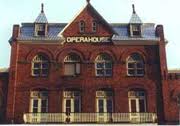The Earlville Opera House, a non-profit in a rural area, has done many things to stay afloat during the pandemic and to move forward, such as relying on donations, federal relief programs and presenting virtual performances, gallery exhibits and fundraisers.
And that is not at all.
“Our mission is a dual mission,” said Executive Director Michelle Connelly. “Not only do we want to enrich the Central New York area and the Southern Tier area through the arts, but we also have a building that needs preservation and care, so we can ensure future generations can use it just like we are now.”
After the Opera House had to close due to the pandemic, its traditional source of income stopped. Connelly said the organization relied on two sources of income: contributed income and earned income. Earned income consisted of ticket sales, selling artwork from the galleries, a gift shop selling regional artisan artwork and the arts café, which sells snacks and drinks during intermission. The contributed income consisted of memberships, donations from patrons, grants from businesses and foundations and fundraisers.
“The main source of income came from admissions from ticket sales for our world-renowned Main Stage performances,” Connelly said.
The Opera House could not host live events during the ban in New York. The Opera House occasionally held virtual events, but the events were free with a voluntary donation option.
“The Opera House Board did a wonderful thing,” Connelly said. “The board members pitched in money to pay some of the performers that were going to be coming in 2020.”
She also said musicians recorded a few songs at their homes and the Opera House paid the people a stipend. The musicians sent in the songs they recorded, and a video was produced that was utilized to raise donations for COVID relief. A link to the video can be found at the bottom of the Opera House website.
“This resulted in many donations, allowing the Opera House to give back a percentage of the proceeds back to the same musicians,” Connelly said. “In fact, they were able to do that twice, helping to support musicians who were halted from touring and making income, too.”
Another thing the Opera House did during the pandemic is present virtual galleries, which it plans to continue after the pandemic. The galleries have expanded audiences and have sold pieces of artwork as far as Mississippi and South Carolina. The Opera House plans to keep this up even after it opens the in-person galleries and plan to keep up with the virtual streaming of different shows and performances.
“The Opera House was invited by the New York State Council on the Arts in mid-2020 to take over administration of a state decentralization program, where the Opera House is now allocating grant funding into three different counties for cultural activities,” said Connelly.
These areas include Broome, Otsego and Chenango counties.
“These are cultural grants for nonprofit organizations and artists that work with nonprofit organizations for grants up to five thousand dollars each,” Connelly said. “The interesting thing about these grants is that when the Opera House started their organization as a nonprofit in 1972, it relied on a grant. So, in this way it is a full-circle moment.”
Arts funding is usually the first thing to be jeopardized in the state budget, but Connelly pointed out how the arts bring people together and offer a way to escape the tumultuous time we are living in. Arts also bring tourism, which drives the economy, and in the absence of the arts during the Pause on New York State, the impact of the arts was felt more than ever.
As the Opera House is a historic building, it has many capital expenses and faces the issue of preserving the history of the building. A few years ago, a heating system was put into the Opera House. This was done so they could do year-round events. Before this change, theatre events stopped in October and did not come back until the month of May. There are no upcoming renovations planned as of now, but the Opera House has a grant application into the Preservation League of NY for a grant to conduct a building condition report to assess current and future building needs.
Connelly said one of the hardest things about working at the Opera House is sustainability.
“There is always a worry about being able to sustain the programs and the staff to run operations,” she said.
She said the best things about working at the Opera House is the excitement when newcomers visit, seeing the happiness that the Opera House brings to people who have been coming for years and the welcoming nature of the community.
Bruce Ward, the Opera House Board President, agrees with Connelly that sustainability is hard and echoed Connelly’s sentiments about the welcoming nature of the community and the people who work at and visit the Opera House.
The first live show is scheduled for Aug. 7, 2021. The Opera House will utilize the time until then to decide what is the best way to do the show as the pandemic continues.
The Earlville Opera House is located at 18 E. Main St., Earlville, and is handicapped-accessible. EOH remains closed for on-site programming until further notice. For more information and updates, visit earlvilleoperahouse.com and like it on Facebook.
EOH events are made possible, in part, with public funds from the New York State Council on the Arts with the support of Governor Andrew Cuomo and the state Legislature and through the generosity of EOH members.
